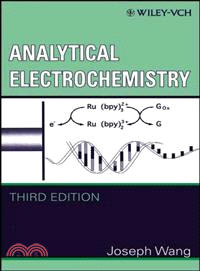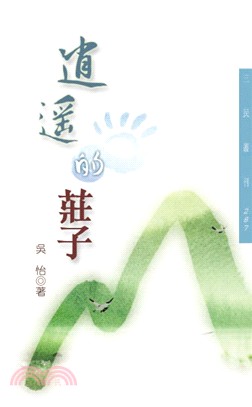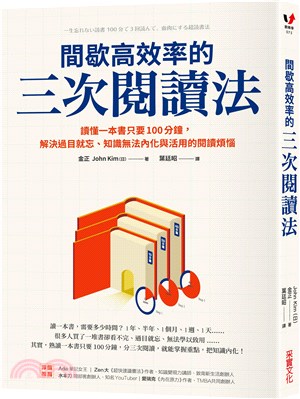Analytical Electrochemistry, Third Edition
- ISBN13:9780471678793
- 出版社:John Wiley & Sons Inc
- 作者:Wang
- 裝訂/頁數:平裝/272頁
- 規格:23.5cm*16.5cm*2.5cm (高/寬/厚)
- 出版日:2006/04/12
定 價:NT$ 7256 元
優惠價:90 折 6530 元
若需訂購本書,請電洽客服 02-25006600[分機130、131]。
相關商品
商品簡介
作者簡介
名人/編輯推薦
目次
商品簡介
Third Edition covers the latest advances in methodologies, sensors, detectors, and mIcrochips
The greatly expanded Third Edition of this internationally respected text continues to provide readers with a complete panorama of electroanalytical techniques and devices, offering a balancebetween voltammetric and potentiometric techniques. Emphasizing electroanalysis rather than physical electrochemistry, readers gain a deep understanding of the fundamentals of electrodereactions and electrochemical methods. Moreover, readers learn to apply their newfoundknowledge and skills to solve real-world analytical problems.
The text consists of six expertly crafted chapters:
* Chapter 1 introduces fundamental aspects of electrode reactions and the structure of the interfacial region
* Chapter 2 studies electrode reactions and high-resolution surface characterization, using techniques ranging from cyclic voltammetry to scanning probe microscopies
* Chapter 3 features an overview of modern finite-current controlled potential techniques
* Chapter 4 presents electrochemical instrumentation and electrode materials, including modified electrodes and ultramicroelectrodes
* Chapter 5 details the principles of potentiometric measurements and various classes of ion selective electrodes
* Chapter 6 explores the growing field of chemical sensors, including biosensors, gas sensors, microchip devices, and sensor arrays
Among the new topics covered, readers discover DNA biosensors, impedance spectroscopy, detection of capillary electrophoresis, diamond electrodes, carbon-nanotube and nanoparticle-based arrays and devices, large-amplitude AC voltammetry, solid-state ion-selective electrodes, ion selective electrodes for trace analysis, and lab-on-a-chip devices. New figures, worked examples, and end-of-chapter questions have also been added to this edition.
Given the rapid pace of discovery and growth of new applications in the field, this text is essential for an up-to-date presentation of the latest advances in methodologies, sensors, detectors, and microchips. It is recommended for graduate-level courses in electroanalytical chemistry and as a supplement for upper-level undergraduate courses in instrumental analysis. The text also meets the reference needs for any industry, government, or academic laboratory engaged in electroanalysis and biosensors.
The greatly expanded Third Edition of this internationally respected text continues to provide readers with a complete panorama of electroanalytical techniques and devices, offering a balancebetween voltammetric and potentiometric techniques. Emphasizing electroanalysis rather than physical electrochemistry, readers gain a deep understanding of the fundamentals of electrodereactions and electrochemical methods. Moreover, readers learn to apply their newfoundknowledge and skills to solve real-world analytical problems.
The text consists of six expertly crafted chapters:
* Chapter 1 introduces fundamental aspects of electrode reactions and the structure of the interfacial region
* Chapter 2 studies electrode reactions and high-resolution surface characterization, using techniques ranging from cyclic voltammetry to scanning probe microscopies
* Chapter 3 features an overview of modern finite-current controlled potential techniques
* Chapter 4 presents electrochemical instrumentation and electrode materials, including modified electrodes and ultramicroelectrodes
* Chapter 5 details the principles of potentiometric measurements and various classes of ion selective electrodes
* Chapter 6 explores the growing field of chemical sensors, including biosensors, gas sensors, microchip devices, and sensor arrays
Among the new topics covered, readers discover DNA biosensors, impedance spectroscopy, detection of capillary electrophoresis, diamond electrodes, carbon-nanotube and nanoparticle-based arrays and devices, large-amplitude AC voltammetry, solid-state ion-selective electrodes, ion selective electrodes for trace analysis, and lab-on-a-chip devices. New figures, worked examples, and end-of-chapter questions have also been added to this edition.
Given the rapid pace of discovery and growth of new applications in the field, this text is essential for an up-to-date presentation of the latest advances in methodologies, sensors, detectors, and microchips. It is recommended for graduate-level courses in electroanalytical chemistry and as a supplement for upper-level undergraduate courses in instrumental analysis. The text also meets the reference needs for any industry, government, or academic laboratory engaged in electroanalysis and biosensors.
作者簡介
JOSEPH WANG, PHD, is Director of the Center for Bioelectronics and Biosensors at the Biodesign Institute and Professor in the Departments of Chemical & Materials Engineering and Chemistry & Biochemistry at Arizona State University. Dr. Wang has authored six books and more than 680 research papers. He holds fifteen patents and is the recipient of the American Chemical Society's Award in Chemical Instrumentation and the Heyrovsky Medal. He was ranked the "Most Cited Electrochemist in the World" in 1995, and was ranked number five on the ISI list of "Most Cited Researchers in Chemistry" for the period 1995 to 2005.
名人/編輯推薦
"Anyone at any level wanting to get involved in electrochemical experimentation should benefit from access to this book." (CHOICE, October 2006)
目次
Preface.
Abbreviations and Symbols.
1. Fundamental Concepts.
1.1 Why Electroanalysis?
1.2 Faradaic Processes.
1.2.1 Mass-Transport-Controlled Reactions.
1.2.1.1 Potential-Step Experiment.
1.2.1.2 Potential-Sweep Experiments.
1.2.2 Reactions Controlled by the Rate of Electron Transfer.
1.2.2.1 Activated Complex Theory.
1.3 Electrical Double Layer.
1.4 Electrocapillary Effect.
1.5 Supplementary Reading.
Problems.
References.
2. Study of Electrode Reactions and Interfacial Properties.
2.1 Cyclic Voltammetry.
2.1.1 Data Interpretation.
2.1.1.1 Reversible Systems.
2.1.1.2 Irreversible and Quasi-reversible Systems.
2.1.2 Study of Reaction Mechanisms.
2.1.3 Study of Adsorption Processes.
2.1.4 Quantitative Applications.
2.2 Spectroelectrochemistry.
2.2.1 Experimental Arrangement.
2.2.2 Principles and Applications.
2.2.3 Electrochemiluminescence.
2.2.4 Optical Probing of Electrode–Solution Interfaces.
2.3 Scanning Probe Microscopy.
2.3.1 Scanning Tunneling Microscopy.
2.3.2 Atomic Force Microscopy.
2.3.3 Scanning Electrochemical Microscopy.
2.4 Electrochemical Quartz Crystal Microbalance.
2.5 Impedance Spectroscopy.
Examples.
Problems.
References.
3. Controlled-Potential Techniques.
3.1 Chronoamperometry.
3.2 Polarography.
3.3 Pulse Voltammetry.
3.3.1 Normal-Pulse Voltammetry.
3.3.2 Differential-Pulse Voltammetry.
3.3.3 Square-Wave Voltammetry.
3.3.4 Staircase Voltammetry.
3.4 AC Voltammetry.
3.5 Stripping Analysis.
3.5.1 Anodic Stripping Voltammetry.
3.5.2 Potentiometric Stripping Analysis.
3.5.3 Adsorptive Stripping Voltammetry and Potentiometry.
3.5.4 Cathodic Stripping Voltammetry.
3.5.5 Abrasive Stripping Voltammetry.
3.5.6 Applications.
3.6 Flow Analysis.
3.6.1 Principles.
3.6.2 Cell Design.
3.6.3 Mass Transport and Current Response.
3.6.4 Detection Modes.
Examples.
Problems.
References.
4. Practical Considerations.
4.1 Electrochemical Cells.
4.2 Solvents and Supporting Electrolytes.
4.3 Oxygen Removal.
4.4 Instrumentation.
4.5 Working Electrodes.
4.5.1 Mercury Electrodes.
4.5.2 Solid Electrodes.
4.5.2.1 Rotating Disk and Rotating Ring Disk Electrodes.
4.5.2.2 Carbon Electrodes.
4.5.2.2.1 Glassy Carbon Electrodes.
4.5.2.2.2 Carbon Paste Electrodes.
4.5.2.2.3 Carbon Fiber Electrodes.
4.5.2.2.4 Diamond Electrodes.
4.5.2.3 Metal Electrodes.
4.5.3 Chemically Modified Electrodes.
4.5.3.1 Self-Assembled Monolayers.
4.5.3.2 Carbon-Nanotube-Modified Electrodes.
4.5.3.3 Sol-gel Encapsulation of Reactive Species.
4.5.3.4 Electrocatalytically Modified Electrodes.
4.5.3.5 Preconcentrating Electrodes.
4.5.3.6 Permselective Coatings.
4.5.3.7 Conducting Polymers.
4.5.4 Microelectrodes.
4.5.4.1 Diffusion at Microelectrodes.
4.5.4.2 Microelectrode Configurations.
4.5.4.3 Composite Electrodes.
Examples.
Problems.
References.
5. Potentiometry.
5.1 Principles of Potentiometric Measurements.
5.2 Ion-Selective Electrodes.
5.2.1 Glass Electrodes.
5.2.1.1 pH Electrodes.
5.2.1.2 Glass Electrodes for Other Cations.
5.2.2 Liquid Membrane Electrodes.
5.2.2.1 Ion Exchanger Electrodes.
5.2.2.2 Neutral Carrier Electrodes.
5.2.3 Solid-State Electrodes.
5.2.4 Coated-Wire Electrodes and Solid-State Electrodes Without an Internal Filling Solution.
5.3 On-line, On-site, and In Vivo Potentiometric Measurements.
Examples.
Problems.
References.
6. Electrochemical Sensors.
6.1 Electrochemical Biosensors.
6.1.1 Enzyme-Based Electrodes.
6.1.1.1 Practical and Theoretical Considerations.
6.1.1.2 Enzyme Electrodes of Analytical Significance.
6.1.1.2.1 Glucose Sensors.
6.1.1.2.2 Ethanol Electrodes.
6.1.1.2.3 Urea Electrodes.
6.1.1.2.4 Toxin (Enzyme Inhibition) Biosensors.
6.1.1.3 Tissue and Bacteria Electrodes.
6.1.2 Affinity Biosensors.
6.1.2.1 Immunosensors.
6.1.2.2 DNA Hybridization Biosensors.
6.1.2.2.1 Background and Principles.
6.1.2.2.2 Electrical Transduction of DNA Hybridization.
6.1.2.2.3 Other Electrochemical DNA Biosensors.
6.1.2.3 Receptor-Based Sensors.
6.1.2.4 Electrochemical Sensors Based on Molecularly Imprinted Polymers.
6.2 Gas Sensors.
6.2.1 Carbon Dioxide Sensors.
6.2.2 Oxygen Electrodes.
6.3 Solid-State Devices.
6.3.1 Ion-Selective Field Effect Transistors.
6.3.2 Microfabrication of Solid-State Sensor Assemblies.
6.3.3 Microfabrication Techniques.
6.3.4 Micromachined Analytical Microsystems.
6.4 Sensor Arrays.
Examples.
Problems.
References.
Index.
Abbreviations and Symbols.
1. Fundamental Concepts.
1.1 Why Electroanalysis?
1.2 Faradaic Processes.
1.2.1 Mass-Transport-Controlled Reactions.
1.2.1.1 Potential-Step Experiment.
1.2.1.2 Potential-Sweep Experiments.
1.2.2 Reactions Controlled by the Rate of Electron Transfer.
1.2.2.1 Activated Complex Theory.
1.3 Electrical Double Layer.
1.4 Electrocapillary Effect.
1.5 Supplementary Reading.
Problems.
References.
2. Study of Electrode Reactions and Interfacial Properties.
2.1 Cyclic Voltammetry.
2.1.1 Data Interpretation.
2.1.1.1 Reversible Systems.
2.1.1.2 Irreversible and Quasi-reversible Systems.
2.1.2 Study of Reaction Mechanisms.
2.1.3 Study of Adsorption Processes.
2.1.4 Quantitative Applications.
2.2 Spectroelectrochemistry.
2.2.1 Experimental Arrangement.
2.2.2 Principles and Applications.
2.2.3 Electrochemiluminescence.
2.2.4 Optical Probing of Electrode–Solution Interfaces.
2.3 Scanning Probe Microscopy.
2.3.1 Scanning Tunneling Microscopy.
2.3.2 Atomic Force Microscopy.
2.3.3 Scanning Electrochemical Microscopy.
2.4 Electrochemical Quartz Crystal Microbalance.
2.5 Impedance Spectroscopy.
Examples.
Problems.
References.
3. Controlled-Potential Techniques.
3.1 Chronoamperometry.
3.2 Polarography.
3.3 Pulse Voltammetry.
3.3.1 Normal-Pulse Voltammetry.
3.3.2 Differential-Pulse Voltammetry.
3.3.3 Square-Wave Voltammetry.
3.3.4 Staircase Voltammetry.
3.4 AC Voltammetry.
3.5 Stripping Analysis.
3.5.1 Anodic Stripping Voltammetry.
3.5.2 Potentiometric Stripping Analysis.
3.5.3 Adsorptive Stripping Voltammetry and Potentiometry.
3.5.4 Cathodic Stripping Voltammetry.
3.5.5 Abrasive Stripping Voltammetry.
3.5.6 Applications.
3.6 Flow Analysis.
3.6.1 Principles.
3.6.2 Cell Design.
3.6.3 Mass Transport and Current Response.
3.6.4 Detection Modes.
Examples.
Problems.
References.
4. Practical Considerations.
4.1 Electrochemical Cells.
4.2 Solvents and Supporting Electrolytes.
4.3 Oxygen Removal.
4.4 Instrumentation.
4.5 Working Electrodes.
4.5.1 Mercury Electrodes.
4.5.2 Solid Electrodes.
4.5.2.1 Rotating Disk and Rotating Ring Disk Electrodes.
4.5.2.2 Carbon Electrodes.
4.5.2.2.1 Glassy Carbon Electrodes.
4.5.2.2.2 Carbon Paste Electrodes.
4.5.2.2.3 Carbon Fiber Electrodes.
4.5.2.2.4 Diamond Electrodes.
4.5.2.3 Metal Electrodes.
4.5.3 Chemically Modified Electrodes.
4.5.3.1 Self-Assembled Monolayers.
4.5.3.2 Carbon-Nanotube-Modified Electrodes.
4.5.3.3 Sol-gel Encapsulation of Reactive Species.
4.5.3.4 Electrocatalytically Modified Electrodes.
4.5.3.5 Preconcentrating Electrodes.
4.5.3.6 Permselective Coatings.
4.5.3.7 Conducting Polymers.
4.5.4 Microelectrodes.
4.5.4.1 Diffusion at Microelectrodes.
4.5.4.2 Microelectrode Configurations.
4.5.4.3 Composite Electrodes.
Examples.
Problems.
References.
5. Potentiometry.
5.1 Principles of Potentiometric Measurements.
5.2 Ion-Selective Electrodes.
5.2.1 Glass Electrodes.
5.2.1.1 pH Electrodes.
5.2.1.2 Glass Electrodes for Other Cations.
5.2.2 Liquid Membrane Electrodes.
5.2.2.1 Ion Exchanger Electrodes.
5.2.2.2 Neutral Carrier Electrodes.
5.2.3 Solid-State Electrodes.
5.2.4 Coated-Wire Electrodes and Solid-State Electrodes Without an Internal Filling Solution.
5.3 On-line, On-site, and In Vivo Potentiometric Measurements.
Examples.
Problems.
References.
6. Electrochemical Sensors.
6.1 Electrochemical Biosensors.
6.1.1 Enzyme-Based Electrodes.
6.1.1.1 Practical and Theoretical Considerations.
6.1.1.2 Enzyme Electrodes of Analytical Significance.
6.1.1.2.1 Glucose Sensors.
6.1.1.2.2 Ethanol Electrodes.
6.1.1.2.3 Urea Electrodes.
6.1.1.2.4 Toxin (Enzyme Inhibition) Biosensors.
6.1.1.3 Tissue and Bacteria Electrodes.
6.1.2 Affinity Biosensors.
6.1.2.1 Immunosensors.
6.1.2.2 DNA Hybridization Biosensors.
6.1.2.2.1 Background and Principles.
6.1.2.2.2 Electrical Transduction of DNA Hybridization.
6.1.2.2.3 Other Electrochemical DNA Biosensors.
6.1.2.3 Receptor-Based Sensors.
6.1.2.4 Electrochemical Sensors Based on Molecularly Imprinted Polymers.
6.2 Gas Sensors.
6.2.1 Carbon Dioxide Sensors.
6.2.2 Oxygen Electrodes.
6.3 Solid-State Devices.
6.3.1 Ion-Selective Field Effect Transistors.
6.3.2 Microfabrication of Solid-State Sensor Assemblies.
6.3.3 Microfabrication Techniques.
6.3.4 Micromachined Analytical Microsystems.
6.4 Sensor Arrays.
Examples.
Problems.
References.
Index.
主題書展
更多主題書展
更多書展本週66折
您曾經瀏覽過的商品
購物須知
外文書商品之書封,為出版社提供之樣本。實際出貨商品,以出版社所提供之現有版本為主。部份書籍,因出版社供應狀況特殊,匯率將依實際狀況做調整。
無庫存之商品,在您完成訂單程序之後,將以空運的方式為你下單調貨。為了縮短等待的時間,建議您將外文書與其他商品分開下單,以獲得最快的取貨速度,平均調貨時間為1~2個月。
為了保護您的權益,「三民網路書店」提供會員七日商品鑑賞期(收到商品為起始日)。
若要辦理退貨,請在商品鑑賞期內寄回,且商品必須是全新狀態與完整包裝(商品、附件、發票、隨貨贈品等)否則恕不接受退貨。
























